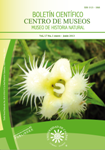Autores/as
Resumen
La conversión de los ecosistemas de bosque tropical a ecosistemas agro pastoriles y otros usos de la tierra continúa imparable en América Latina. El presente documento comprende un estudio comparativo en el cual se evaluó el grado de fragmentación del bosque durante un periodo de 23 años (entre 1973 y 1996) en dos áreas localizadas dentro de la misma región ecológica, pero en dos países (Colombia y Ecuador) que exhiben diferentes patrones de colonización antrópica. Se usaron índices de estructura del paisaje para evaluar el grado de fragmentación del bosque a ambos lados de la frontera internacional. Los resultados muestran que la extensión de la fragmentación del bosque ha sido considerablemente mayor en el lado colombiano, lo que sugiere que los ecosistemas naturales podrían estar sujetos a mayores presiones de degradación, con efectos perjudiciales potencialmente importantes sobre la abundancia y distribución de la biota.
Palabras clave
Citas
AS, S., 1999. Invasion of matrix species in small habitat patches. Conservation Ecology [online] 3(1):1. Available from the Internet. URL: http://www.consecol.org/vol3/iss1/art1.
CHAZDON, R.L., 1999. Tropical forests: Log them or leave them? Science 281: 1295.
COCHRANE, M.A., ALENCAR, A. SCHULZE, M.D. SOUZA, C.M. NEPSTAD, D.C. LEFEBVRE, P. & DAVIDSON, E.A., 1999. Positive feedbacks in the fire dynamic of closed canopy tropical forests. Science 284:1832-1835.
DALE, V.H. & PEARSON, S.M., 1997. Quantifying habitat fragmentation due to land use change in Amazonia. In: Laurance, W.F. & Bierregaard, R.O. (Eds.) Tropical forest remnants. Ecology, management and conservation of fragmented communities. Pp. 400-409. The University of Chicago Press.
DODSON, C.H. & GENTRY, A.H., 1991. Biological extinction in western Ecuador. Annals of the Missouri Botanical Garden 78: 273-295.
ERDAS., 1997. ERDAS Field Guide. Atlanta, Georgia: ERDAS, Inc.
GENTRY, A.H., 1992. Tropical forest biodiversity: Distributional patterns and their conservational significance. Oikos, 63: 19-28.
HARRIS, L.D., 1984. The fragmented forest. Island biogeography theory and the preservation of biotic diversity. The University of Chicago Press. Chicago and London.
HERNÁNDEZ-CAMACHO, J. HURTADO-GUERRA, A. ORTIZ-QUIJANO, R. & WALSCHBURGER, T., 1992. Unidades biogeográficas de Colombia. In: Halffter, G. (Ed.). La diversidad biológica de Iberoamérica. Instituto de Ecologia, A.C., Mexico.
HOLDRIDGE, L.R., 1967. Life zone ecology. Tropical science center. San José, Costa Rica.
JENSEN, J.R., 1996. Introductory digital image processing. A remote sensing perspective. Second Edition. Prentice Hall.
MCGARIGAL, K. & MARKS, B.J., 1995. FRAGSTATS: Spatial pattern analysis program for quantifying landscape structure. General Technical Report PNW-GTR-351. United States Deparment of Agriculture. Pacific Northwest Research Station.
MEFFE, G.K. & CARROLL, C.R., 1997. Principles of Conservation Biology. 2nd.Edition. Sunderland, Mass. Sinauer
MERRIAM G. & WEGNER, J., 1992. Local extinctions, habitat fragmentation and ecotones. Chapter 9 in: Hansen, A.J. & DiCastri, F. (Eds.). Landscape boundaries. Springer-Verlag.
METZGER, J.P., 1997. Relationships between landscape structure and tree species diversity in tropical forests of South-east Brazil. Landscape and Urban Planning 37: 29-35.
NEPSTAD, D.C. MOREIRA, A. VERISSIMO, A. LEFEBVRE, P. SCHLESINGER, P. POTTER, C. NOBRE, C. SETZER, A. KRUG, T. BARROS, A.C. ALENCAR, A. & PEREIRA, J.R., 1998. Forest fire prediction and prevention in the Brazilian Amazon. Conservation Biology 12:951-953.
NEPSTAD, D.C. VARISSIMO, A. ALENCAR, A. NOBRE, C. LIMA, E. LEFEBVRE, P. SCHLESINGER, P. POTTER, C. MOUTINHO, P. MENDOZA, E. COCHRANE, M. & BROOKS, V., 1999. Large-scale impoverishment of Amazonian forests by logging and fire. Nature 398: 505-508.
NOSS, R., 1983. A regional landscape approach to maintain diversity. BioScience 33 (11): 700-706.
PATTON, D.R., 1975. A diversity index for quantifying habitat edge. Wildlife Society Bulletin 3: 171-173.
PRANCE, G.T., 1977. The phytogeographical support for the theory of Pleistocene forest refuges in the Amazon basin, based on evidence from distribution patterns in Caryocaraceae, Chrysobalanaceae, Dychapetalaceae and Lecythidaceae. Acta Amazonica 3: 5-8.
SALDARRIAGA, J.G. & WEST, D.C., 1986. Holocene fires in the northern Amazon basin. Quaternary Research 26: 358-366.
SAUNDERS, D.A. HOBBS, R.J. & MARGULES, C.R., 1991. Biological consequences of ecosystem fragmentation: A review. Conservation Biology 5: 18-32.
SCHUMAKER, N.H., 1996. Using landscape indices to predict habitat connectivity. Ecology 77:1210-1225.
SIMBERLOFF, D., 1976. Species turnover and equilibrium island biogeography. Science 194:572-578.
SIMBERLOFF, D., 1990. Species-area relationships, fragmentation, and extinction in tropical forests. In: Proceedings of the international conference on tropical biodiversity "In Harmony with Nature". Kuala Lumpur, Malaysia.
SOUBIES, F. SUGUIO, K. & VOLKMER-RIBEIRO, C., 1998. Amazonia rainforest fires: A lacustrine record of 7000 years. Ambio 27: 139-142.
TURNER, M.G., 1989. Landscape ecology: The effect of pattern and process. Annual Review of Ecology and Systematics 20: 171-197.
VIÑA, A. & CAVELIER, J., 1999. Deforestation rates (1938-1988) of tropical lowland forests on the Andean foothills of Colombia. Biotropica 31: 31-36.
VIÑA, A. ECHAVARRIA, F.R. & RUNDQUIST, D.C., 2004. Satellite change detection analysis of deforestation rates and patterns along the Colombia-Ecuador border. AMBIO 33: 118-125.
WALKER, L.R. SILVER, W.L. WILLIG, M.R. & ZIMMERMAN, J.K., (Eds.). 1996. Long Term Responses of Caribbean Ecosystems to Disturbance. Biotropica 28 (4a). Special Issue.
WILCOVE, D.S. MCLELLAN, C.H. & DOBSON, A.P., 1986. Habitat fragmentation in the temperate zone. In: Soule, M.E. (Ed.). Conservation Biology. Sinauer Associates, Inc. Publishers. Massachusetts.
WILCOX, B.A., 1980. Insular Ecology and Conservation. In: Soule, M.E. & Wilcox, B.A. (Eds.). Conservation Biology. Sinauer Associates, Inc. Publishers. Sunderland, Massachussetts.

 PDF (English)
PDF (English)
 FLIP
FLIP



















